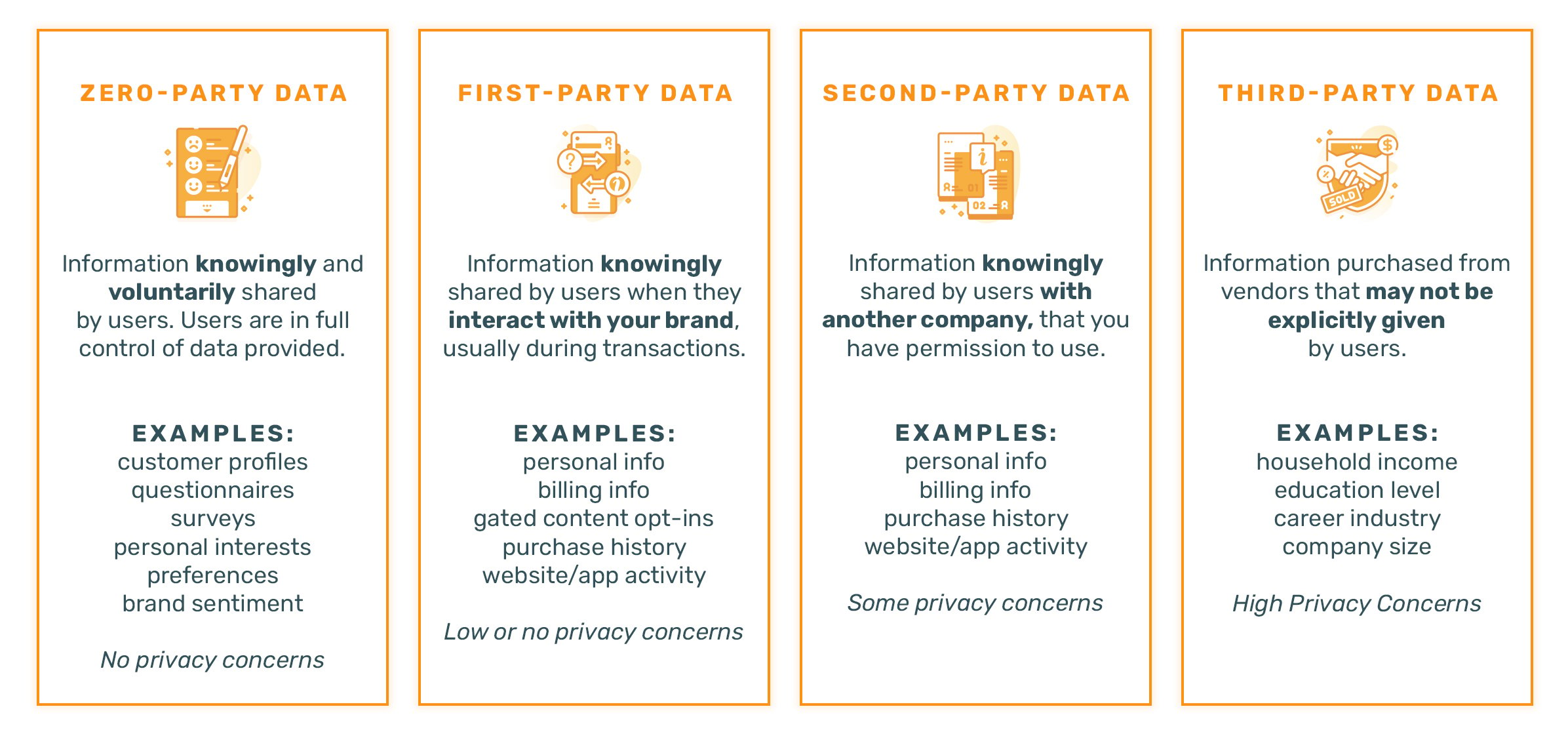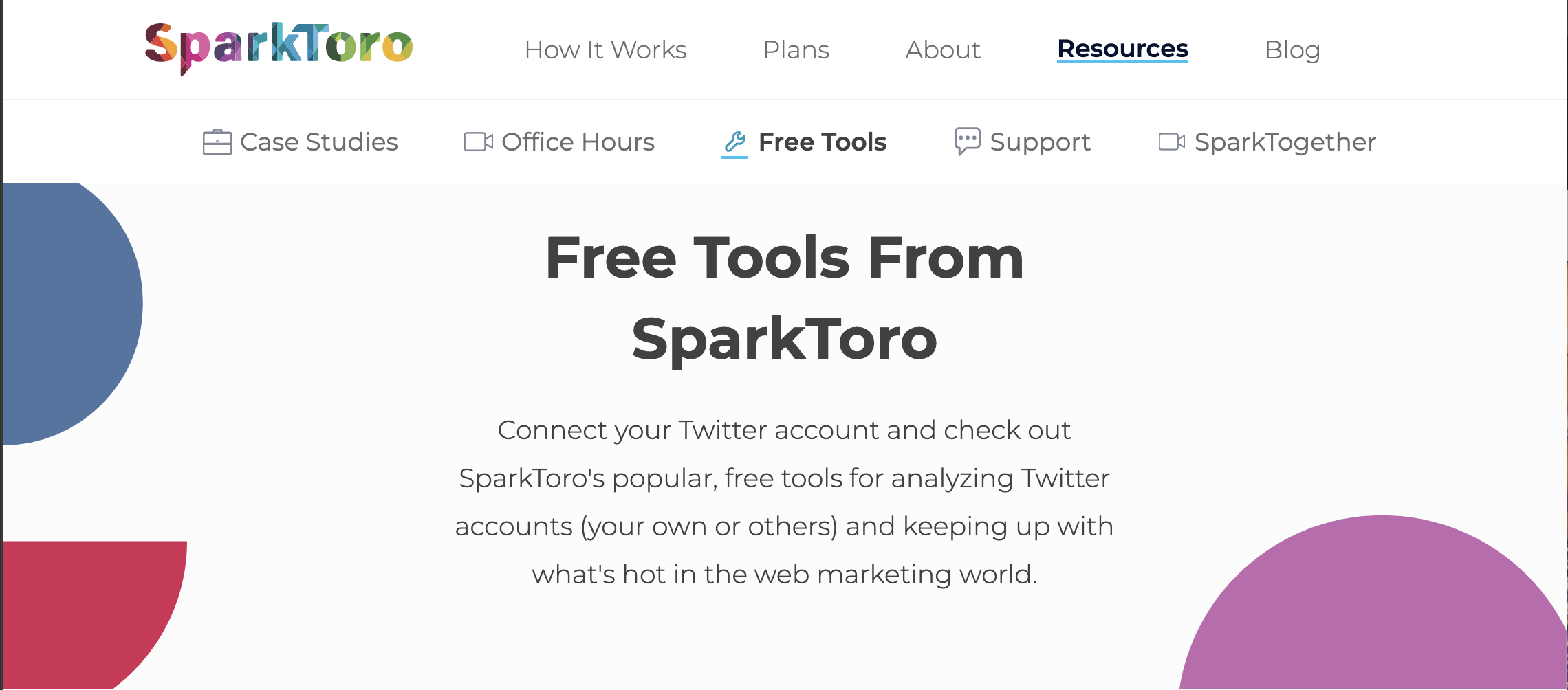What is zero-party data and is it here to stay?

Zero-party data is a new and exciting development in the world of digital marketing. It offers a more personalized and meaningful approach to data collection that respects customer privacy and creates a more transparent relationship between businesses and consumers.
However, as with any emerging trend, questions have arisen about its staying power in the ever-changing world of data privacy and marketing. In this blog post, we'll explore what zero-party data is, how it differs from other data types, and whether it's a viable marketing strategy for businesses.
Join us as we delve into the world of zero-party data and discover what it means for the future of digital marketing.
Data: a history
Since the first B2B SaaS company emerged from the primordial internet ooze of the late 1990s, you’ve undoubtedly witnessed significant changes in business practices and customer data collection. With growing concerns regarding privacy and an increasing number of documented security breaches, consumers are cautious about who has access to their data and what it’s being used for, leading to a shift in how companies handle sensitive information.
In the early days of the internet, security was the main concern, but with the rise of companies like Google and social media sites like Facebook and Twitter, privacy became a more pressing issue. Companies use algorithms to predict consumer behavior and generate ad revenue, but some consumers may need help understanding the extent to which their behavior is being tracked. Efforts to self-regulate online advertising and educate consumers have been made, but there is still room for improvement in ensuring data privacy.
Google says goodbye to third-party cookies
Google initially announced in January 2020 that it would be phasing out support for third-party cookies in its Chrome browser by 2022. Since then, Google has extended the timeline multiple times, with the latest end date of 2024. The delay was due to concerns from stakeholders in the digital advertising ecosystem and regulatory concerns related to privacy and competition.
Google wants to ensure the industry has enough time to adapt to the new changes and is working on developing new technologies that can replace the functionality currently provided by third-party cookies. The aim is to create a smoother transition to the new digital advertising ecosystem while also ensuring that user privacy is protected.
Hello, zero-party data
Thankfully, this timeline extension has given B2B SaaS marketers much needed time to think outside of the box and begin utilizing much less intrusive data collection methods.
That’s where zero-party data comes in: a new, more meaningful, and personalized way to collect the data you need while respecting the customer’s rights to their data privacy. This new approach to data collection is a win-win scenario that benefits both marketers and customers alike.
Understanding zero-party data
Zero-party data is a relatively new concept in the field of data privacy and collection. It aims to address the growing concern about the amount of personal information being collected by companies without the explicit consent of the individual. Traditional approaches to data collection often rely on obtaining personal information through various means such as filled-out forms, browsing history, and cookie tracking, which can be intrusive and raise privacy concerns.
Zero-party data is voluntarily shared by consumers, rather than being collected by the company or obtained from a third-party source. Unlike first-party and third-party data, zero-party data is obtained through active and explicit consent from consumers, who choose to share their information in exchange for benefits such as personalized experiences, rewards, or discounts.

Zero-party data operates on the principle of voluntary and transparent data sharing. Individuals have the choice to share specific pieces of information with companies if they want to. The information is shared in a secure and encrypted manner, and the consumer retains control over the data and has the freedom to withdraw their permission at any time.
The goal of zero-party data is to create a mutually beneficial relationship between individuals and companies. B2B SaaS marketers can obtain the data they need to personalize and improve their products and services, while customers retain control over their personal information and can choose to share it if they trust the company and feel comfortable with the information being shared.
In essence, zero-party data empowers individuals by giving them greater control over their personal data and allowing them to make informed decisions about what information they want to share. This helps to build trust between individuals and companies, leading to more meaningful and personalized experiences for everyone involved.
The rise of zero-party data
The GDPR and the CCPA are two of the most significant privacy regulations that have been introduced in recent years. Both regulations have had a significant impact on the way companies collect, process, and use personal data.
One of the main impacts of these regulations is increased transparency and accountability for companies. Under GDPR and CCPA, companies are required to clearly explain how they collect and use personal data, as well as obtain explicit consent from consumers for the use of their information. This has made it easier for consumers to understand how their data is being used.
These regulations have given consumers more control over their personal data. Under GDPR and CCPA, consumers have the right to request that their data be deleted or that it not be shared with third parties. This has increased the power dynamic between consumers and companies and made it easier for consumers to protect their privacy.
These regulations, coupled with the consumer’s desire to further protect their data and Google’s phasing out of third-party cookies, leave very few viable, trustworthy, and effective methods to collect the data you need. Zero-party has now become the most favorable solution.
In the long run, zero-party data has the potential to provide significant benefits for businesses, including improved customer experiences, increased customer trust, better data quality, reduced data privacy concerns, and improved data security.
How to implement zero-party data for your B2B SaaS marketing efforts
Zero-party data is becoming an increasingly important part of B2B SaaS marketing. This type of data is highly valuable for creating personalized marketing strategies and enhancing the customer experience.
Let's take a moment to discuss how to assess your current data collection methods, identify the data you need, develop a strategy for zero-party data collection, and outline best practices for using zero-party data in your marketing efforts.
- Assess your current data collection methods: Review your current data collection methods and determine their effectiveness. This may involve looking at the types of data you collect, the sources of that data, and the processes and systems you have in place for storing and using it.
- Identify the data you need for your marketing efforts: Next, determine what data is most important and what information you need to support those efforts. This might include information about your target audience, such as their preferences, behaviors, and buying habits.
- Develop a strategy for zero-party data collection: Develop a strategy for collecting data through zero-party methods such as creating opt-in forms, surveys, or quizzes that allow customers to share their information in exchange for something of value.
- Best practices for using zero-party data in your marketing efforts: Create privacy policies that are transparent and easy to understand, regularly review your data collection practices, and always be transparent with your customers about how you use their data.
One of the best ways to collect a massive amount of data quickly is to offer free tools to visitors in exchange for access to the valuable information you need (with their permission, of course).
Here’s a great example of this type of zero-party B2B SaaS data collection in action:

Sparktoro provides three exceptional and complimentary tools. By utilizing these tools, the user grants access to their Twitter account, from which Sparktoro can gather significant amounts of valuable information (with the visitor’s permission).
The beauty of collecting data through free tools is that it's actually accurate, unlike human opinions. The consolidated data obtained from your users' tools is priceless and provides a clearer understanding than other methods. Additionally, free tools are often widely used and effortless to market, making them a critical aspect of expanding your business, attracting more leads, and raising brand recognition.
Conclusion
Zero-party data is a game-changer in the data privacy and collection space, offering a mutually beneficial solution for B2B SaaS marketers and consumers. By giving individuals greater control over their personal data, companies can collect the information they need in a secure and transparent manner, leading to more meaningful and personalized experiences. As privacy regulations continue to evolve and consumers become increasingly concerned about data privacy, zero-party data offers a solution that is both compliant and customer-centric.
Zero-party data is a viable solution for B2B SaaS marketers, particularly in light of recent privacy regulations and Google’s plan to phase out third-party cookies by 2024.
Due to these trends and developments, B2B SaaS marketers are advised to embrace zero-party data as a central part of their data-centric approach. By prioritizing customer privacy and building trust, companies can stay ahead of the curve and continue to deliver value to their customers.
In today’s rapidly changing digital landscape, zero-party data is here to stay, offering a path forward if you’re looking to balance the needs of your customers with the needs of your business.
March 2, 2023
